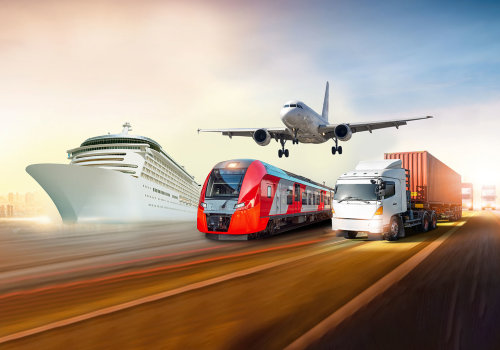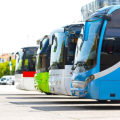High-speed rail services are becoming a popular option for commuters and travelers alike. From increasing convenience to reducing travel times, high-speed rail services are changing the way we move from one place to another. In this article, we explore the benefits of high-speed rail services and how they are revolutionizing public transportation. High-speed rail services offer a comfortable and efficient way to move people across large distances in a short amount of time. With speeds reaching up to 320 kilometers per hour, high-speed rail services can cover large distances in a fraction of the time it would take by car or bus.
This is particularly beneficial for travelers who are looking to save time or those who may not have access to other forms of transportation. In addition, high-speed rail services can be more economical than other modes of transportation. For commuters, the cost of taking a high-speed train may be cheaper than driving a car or taking a bus. Furthermore, high-speed rail services are often more reliable than other forms of transportation, providing passengers with the peace of mind that they will get to their destination on time. Finally, high-speed rail services are becoming increasingly popular due to their environmental benefits.
By reducing emissions and decreasing reliance on fossil fuels, high-speed rail services can help reduce our carbon footprint while providing an efficient form of transportation. In this article, we will explore how high-speed rail services are revolutionizing public transportation and examine the benefits they offer. We will look at how they compare to other forms of transportation and discuss the potential environmental impact of these services. The first thing to understand about high-speed rail services is that they are much faster than regular trains. This allows passengers to travel longer distances in a shorter amount of time. High-speed rail services also tend to be more comfortable than traditional train services, as they offer more amenities such as WiFi, reclining seats, and catering services.
In addition to being faster and more comfortable than traditional train services, high-speed rail services also have a much lower environmental impact than air travel. High-speed rail services use electricity as their primary fuel source, meaning they emit far fewer emissions than airplanes. This makes them a much more sustainable option for travelers looking to reduce their carbon footprint. Another benefit of high-speed rail services is their cost-effectiveness. They tend to be much cheaper than air travel, making them an attractive option for budget-conscious travelers.
High-speed rail services also tend to be more reliable than traditional train services, with fewer delays and cancellations. Finally, high-speed rail services are often much more convenient than air travel. Many countries have built dedicated high-speed rail lines that offer direct service from major cities, allowing passengers to avoid the hassle of transferring between airports and train stations. There are currently several countries that offer high-speed rail services. Some of the most notable are France, Germany, Japan, China, and Spain.
Each country has its own set of rules and regulations regarding access to its high-speed rail network, so it's important to research each one before planning your trip. In addition to researching the rules and regulations of each country's high-speed rail network, it's also important to understand how to access the services themselves. Most countries offer a variety of ticket options, including single tickets, return tickets, and multi-trip tickets. It's also important to research the different types of trains available on each network – some networks offer express trains that stop at fewer stations, while others offer local trains that stop at more stations. Once you've researched the different networks and chosen the best option for you, it's time to purchase your ticket.
Most networks offer online ticketing systems that allow you to purchase tickets with a credit or debit card. It's important to note that some networks require you to purchase your ticket in advance – so be sure to check the terms and conditions before booking your trip. Once you've purchased your ticket, it's time to board your train! Most high-speed rail networks offer dedicated waiting areas for passengers with tickets – so make sure you know where to go when it's time for your departure.
High-speed rail services
provide a convenient and cost-effective alternative to air travel, making them an attractive option for travelers looking to reduce their carbon footprint or save money on their next trip. With a bit of research and planning, anyone can access these services – so why not give them a try?Countries That Offer High-Speed Rail Services
High-speed rail services are available in many countries around the world. In Europe, France, Germany, Italy, Spain, and the UK have some of the most extensive high-speed rail networks.China is home to the world’s longest high-speed rail line, and Japan has the most comprehensive network. Other countries with high-speed rail services include Brazil, Canada, India, Russia, South Africa, South Korea, and Taiwan. Most high-speed rail services require passengers to book their tickets in advance. In Europe, tickets can be booked online via the Rail Europe website. In China and Japan, you can purchase tickets at any railway station.
In other countries, tickets can be purchased from a travel agent or directly from the railway station. When travelling by high-speed rail, it is important to check the schedule before departure. Many high-speed trains run at specific times and may have limited availability. It is also important to check the baggage restrictions as some high-speed trains have strict weight limits for luggage.
How To Access High-Speed Rail Services
Accessing high-speed rail services is usually quite straightforward. Most countries offer online ticketing systems, allowing passengers to purchase tickets from the comfort of their own homes.Additionally, many train stations also have ticket offices that can provide assistance with purchasing tickets. When purchasing tickets, it's important to take note of the train's departure time and the station at which it will depart from. Some train lines require passengers to select a specific train car when buying tickets, so it's important to check for this information as well. Once a ticket has been purchased, passengers should arrive at the station at least 15 minutes before the scheduled departure time.
This will ensure that there is sufficient time to board the train and to stow any luggage. When boarding, passengers should show their ticket to the conductor and follow any instructions they may provide. It's important to note that in many countries, high-speed rail services require passengers to purchase a reserved seat when purchasing their ticket. This means that passengers should be sure to select a seat before boarding the train.
Additionally, some trains may require passengers to scan their ticket at the entrance of each car.
The Benefits of High-Speed Rail Services
High-speed rail services offer an array of benefits to passengers, making them a convenient and cost-effective alternative to air travel. With speeds up to 300 mph, high-speed rail services provide a fast way to cover long distances, as well as increased comfort and convenience for passengers. In addition, high-speed rail services have a significantly lower environmental impact than air travel, helping to reduce greenhouse gas emissions.Furthermore, high-speed rail services are typically more cost-effective than air travel, making them an attractive option for travelers. The speed of high-speed rail services is one of their primary advantages. Passengers can travel long distances quickly, while enjoying the comfort of the train. Additionally, the fast speed of high-speed rail services allows passengers to reach their destination earlier than they would with other modes of transportation. High-speed rail services also offer a more comfortable ride than other modes of transportation.
The trains are designed with comfortable seating and spacious cabins, providing passengers with a relaxed and enjoyable journey. Furthermore, the stations are often located in city centers, allowing passengers easy access to their destination. In addition to speed and comfort, high-speed rail services have a significantly lower environmental impact than air travel. High-speed trains use less energy than airplanes and emit fewer pollutants into the atmosphere. This helps to reduce greenhouse gas emissions and minimize air pollution. High-speed rail services are also typically more cost-effective than air travel.
Prices for train tickets are often lower than those for flights, allowing passengers to save money on their travels. Furthermore, passengers can usually purchase tickets in advance, allowing them to take advantage of discounted fares. Finally, high-speed rail services offer increased convenience for passengers. Trains are often more reliable than other modes of transportation and provide direct access to city centers, eliminating the need for additional transfers or taxi rides. Additionally, some trains even offer on-board Wi-Fi, allowing passengers to stay connected while they travel. In conclusion, high-speed rail services provide a convenient and cost-effective alternative to air travel, allowing passengers to travel long distances quickly with minimal environmental impact.
There are numerous countries that offer high-speed rail services, and accessing them is often just a matter of research and planning. With the range of benefits that high-speed rail services provide, there is no reason not to give them a try.











Leave Message